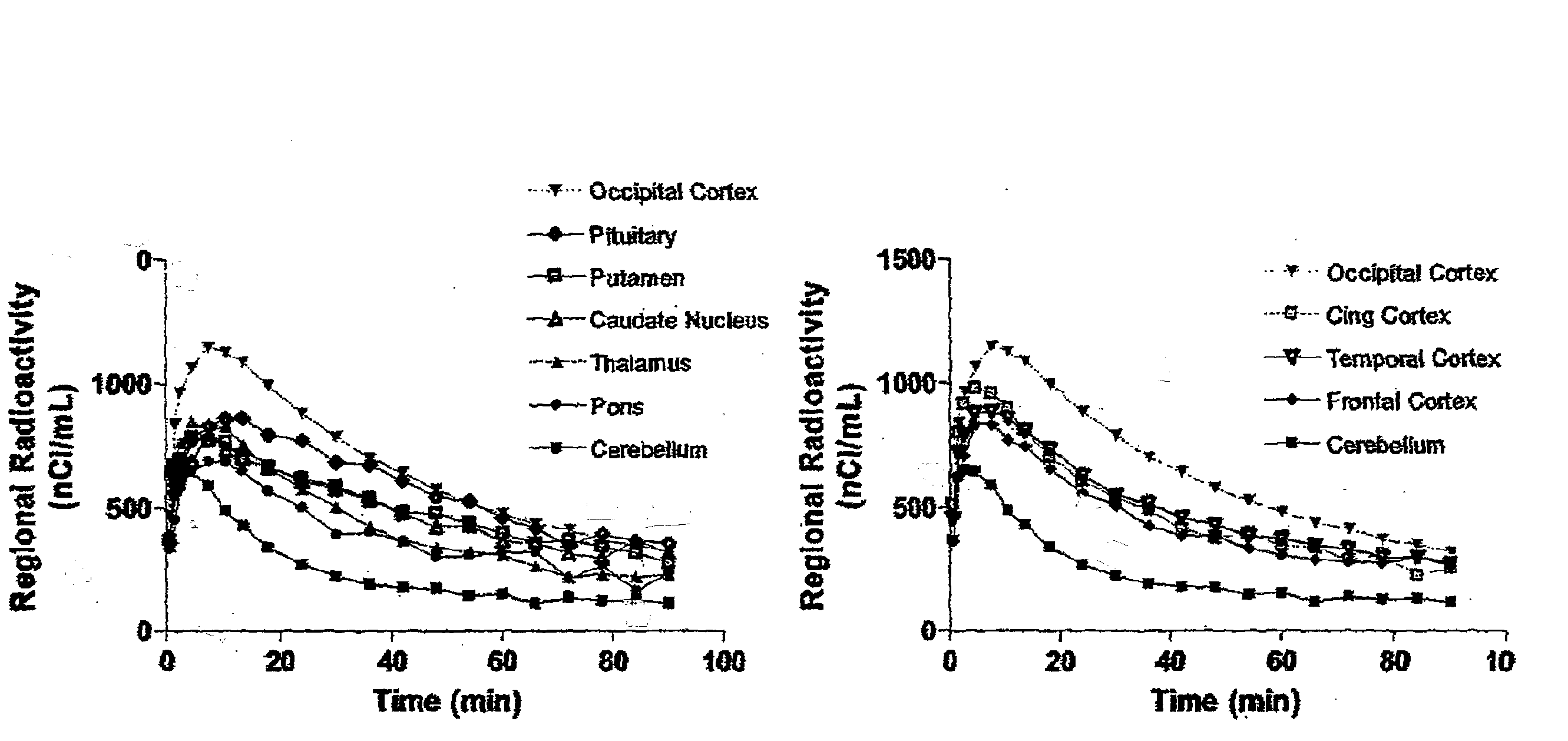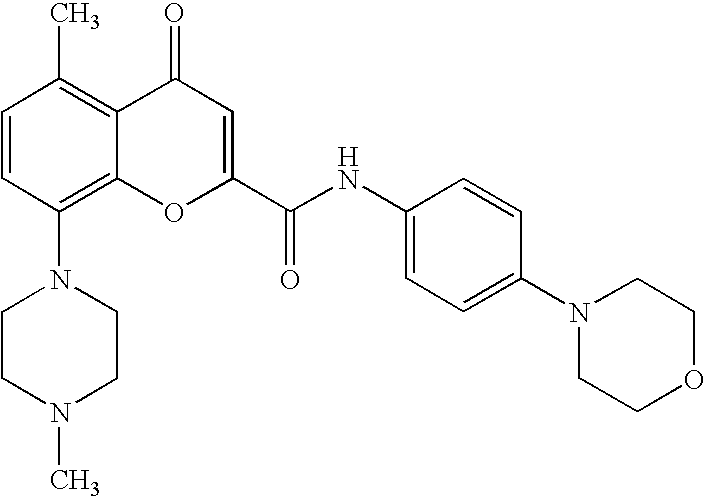Radioligands for the 5 -Ht1b Receptor
- Summary
- Abstract
- Description
- Claims
- Application Information
AI Technical Summary
Problems solved by technology
Method used
Image
Examples
example 1
Synthesis of Radioligand Precursor (8-(1-piperazinyl)-5-methylchrom-2-en-4-one-2-(4-morpholinophenyl)carboxamide)
[0028]
[0029]A 12.82 g (89.9 mmole) portion of 2-chloro-5-methylphenol can be dissolved in 75 mL of diethyl ether. A 10.9 g (107.9 mmole) portion of triethylamine is added dropwise with stirring, followed dropwise by 14.04 g (98.9 mmoles) of dimethyl acetylenedicarboxylate, producing a mild warming. The reaction mixture should be stirred overnight at room temperature, then transferred using rinses of ether, and a little THF to dissolve some residue, into a separatory funnel. The mixture should be washed two times with 200 mL of 1N NaOH, once with water, then twice with saturated NaCl, and finally dried over MgSO4. Filtration and removal of solvent by rotary evaporation provides a pale yellow clear oil which is carried directly into the next reaction.
[0030]The oil from the preceding step can be taken up in 50 mL of EtOH and this solution can be added slowly with stirring to...
example 2
Synthesis of Tritiated Radioligand [3H] 8-(4-methylpiperazin-1-yl)-5-methylchrom-2-en-4-one-2-(4-morpholinophenyl)carboxamide)
[0036]To 1.6 mg (3.57 umole) of precursor 8-piperazin-1-yl-5-methylchrom-2-en-4-one-2-(4-morpholinophenyl)carboxamide in 0.3 ml DMF is added 100 mCi of C3H3I (in 100 μl DMF solution, Amersham) finally 100 μl DMF used as wash to give a total of 0.5 mL reaction volume. The reaction is sealed and placed in a 100-110° C. oil bath and heated for 50 minutes with stirring. The reaction mixture is allowed to cool and 6 mg of Boc anhydride added and heated sealed for 60 minutes. The volatiles can be removed and the product can be dissolved in acetonitrile and 0.1% TFA in water 50 / 50. The product is isolated on HPLC C18 Phenomex Luna column (10×50 cm; Gradient 20-60% acetonitrile (0.1% TFA) in 10 minutes (retention time=8.1 minutes). The major factions of separate isolation runs are combined; evaporated and redisolved in EtOH (6.3 mL) giving 26.8 mCi (4.25mCi / mL) at 80...
example 3
Synthesis of 11C Radioligand: [11C] 8-(4-methylpiperazin-1-yl)-5-methylchrom-2-en-4-one-2-(4-morpholinophenyl)carboxamide)
[0037][11C] 8-(4-methylpiperazin-1-yl)-5-methylchrom-2-en-4-one-2-(4-morpholinophenyl)carboxamide) can be prepared by methylation of the corresponding demethylated precursor 8-piperazin-1-yl-5-methylchrom-2-en-4-one-2-(4-morpholinophenyl)carboxamide) using [11C]methyl triflate and purified by HPLC. The collected fraction from HPLC can be evaporated and the residue redissolved into 8 mL sterile physiological phosphate buffer (pH=7.4). After sterile filtration the formulated product solution will be sterile and free from pyrogens.
[0038]Cynomolgus monkey can be used to determine the suitability of [11C] labeled raidoligands as a radioligand for PET-determination of 5HT1B-receptor binding and occupancy. Anaesthesia can be induced and maintained by repeated intramuscular injections of a mixture of ketamine (3-4 mg / kg per h Ketalar, Parke-Davis) and x...
PUM
| Property | Measurement | Unit |
|---|---|---|
| Force | aaaaa | aaaaa |
| Electric charge | aaaaa | aaaaa |
| Composition | aaaaa | aaaaa |
Abstract
Description
Claims
Application Information
 Login to view more
Login to view more - R&D Engineer
- R&D Manager
- IP Professional
- Industry Leading Data Capabilities
- Powerful AI technology
- Patent DNA Extraction
Browse by: Latest US Patents, China's latest patents, Technical Efficacy Thesaurus, Application Domain, Technology Topic.
© 2024 PatSnap. All rights reserved.Legal|Privacy policy|Modern Slavery Act Transparency Statement|Sitemap



